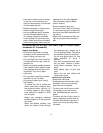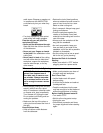
6
Safety Instructions For Table Saws (continued)
Plan your work
• Use the right tool. Don’t force tool or
attachment to do a job it was not
designed for.
Inspect your workpiece.
• Make sure there are no nails or for-
eign objects in the part of the work-
piece to be cut.
• When cutting irregularly shaped
workpieces, plan your work so it will
not slip and pinch the blade:
- A piece of molding for example,
must lie flat or be held by a fixture
or jig that will not let it twist, rock or
slip while being cut. Use jigs or fix-
tures where needed to prevent
workpiece from shifting.
• Use a different, better suited type of
tool for work that can’t be made sta-
ble.
Plan your cut
• To reduce the risk of kickbacks and
throwbacks - when a part or all of
the workpiece binds on the blade
and is thrown violently back toward
the front of the saw:
• Never cut Freehand. Always use
either a rip fence, miter gauge or fix-
ture to position and guide the work,
so it won’t twist or bind on the blade
and kick back.
• Make sure there’s no debris
between the workpiece and its sup-
ports.
• Use extra caution with large, very
small or awkward workpieces.
• Use extra supports (tables, saw
horses, blocks, etc.) for any work-
pieces large enough to tip when not
held down to the table top. Never
use another person as a substitute
for a table extension, or as addi-
tional support for a workpiece that is
longer or wider than the basic saw
table, or to help feed, support or pull
the workpiece.
• Never confine the piece being cut
off, that is, the piece not against the
rip fence, miter gauge or fixture.
Never hold it, clamp it, touch it, or
use length stops against it. It must
be free to move. If confined, it could
get wedged against the blade and
cause a kickback or throwback.
• Never cut more than one workpiece
at a time.
• Never turn your table saw “ON”
before clearing everything except
the workpiece and related support
devices off the table.
Plan Ahead To Protect Your Eyes, Hands, Face and Ears
Dress for safety
• Do not wear loose clothing, gloves,
neckties or jewelry (rings, wrist
watches). They can get caught and
draw you into moving parts.
• Wear nonslip footwear.
• Tie back long hair.
• Roll long sleeves above the elbow.
• Noise levels vary widely. To reduce
the risk of possible hearing damage,
wear ear plugs or muffs when using
table saw for hours at a time.
• Any power saw can throw foreign
objects into the eyes. This can result
in permanent eye damage. Always
wear safety goggles, not glasses
complying with ANSI Z87.1 (or in
Canada CSA Z94.3-99) shown on
package. Everyday eyeglasses
have only impact resistant lenses.
They are not safety glasses. Safety
goggles are available at many local


















